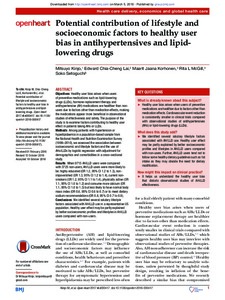Potential contribution of lifestyle and socioeconomic factors to healthy user bias in antihypertensives and lipidlowering drugs
Soko Setoguchi; Mitsuyo Kinjo; Edward Chia-Cheng Lai; Maarit Jaana Korhonen; Rita L McGill
https://urn.fi/URN:NBN:fi-fe2021042718800
Tiivistelmä
Objectives Healthy user bias arises when users of preventive medications such as lipid-lowering drugs (LLDs), hormone replacement therapy and antihypertensive (AH) medications are healthier than non-users due to factors other than medication effects, making the medications appear more beneficial in observational studies of effectiveness and safety. The purpose of the study is to examine factors contributing to healthy user effect in patients taking AHs or LLDs.
Methods: Among patients with hypertension or hyperlipidaemia in a population-based sample from the National Health and Nutrition Examination Survey (1999–2010), we assessed the association between socioeconomic and lifestyle factors and the use of AHs/LLDs by logistic regression with adjustment for demographics and comorbidities in a cross-sectional study.
Results: When 9715 AH/LLD users were compared with 3725 non-users, AH/LLD users were more likely to be: highly educated (OR 1.2, 95% CI 1.2 to 1.3), non-impoverished (OR 1.3, 95% CI 1.2 to 1.4), current non-smokers (OR 1.2, 95% CI 1.1 to 1.4), physically active (OR 1.1, 95% CI 1.0 to 1.2) and consume more calcium (OR 1.1, 95% CI 1.0 to 1.3) but less likely to have normal body mass index (OR 0.6, 95% CI 0.6 to 0.7) or to meet dietary sodium recommendations (OR 0.8, 95% CI 0.7 to 0.9).
Conclusions: We identified several salutary lifestyle factors associated with AH/LLD use in a representative US population. Healthy user effect may be partly explained by better socioeconomic profiles and lifestyles in AH/LLD users compared with non-users.
Kokoelmat
- Rinnakkaistallenteet [27094]
